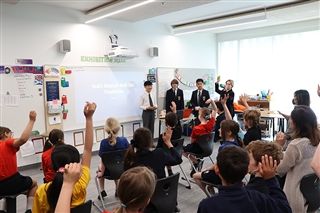The exhibition is the culmination of a student’s experience in the Primary Years Programme and marks their transition from the PYP to MYP (Middle Years Programme). The Exhibition process gives the students the opportunity to take ownership of their learning and to put to use all the skills they have developed during their time in the Junior School.
Students spent several weeks researching, documenting and creating to produce their final projects. Students inquired into “How to World Works” where they explored how humans use their understanding of scientific principles and the impact of scientific and technological advances on society and the environment.
This year the exhibition included 10 central ideas:
-
Common materials can be revised to create something purposeful.Problems can be solved through design modification.The properties of light can be transformative.How we live and our understanding of the environment influence design.Scientific experimentation can lead to design innovation.Design and function include choice and purpose of materials.The operating systems of technological devices can be harnessed to achieve a purpose.Features are interconnected and influence performance.Perspective changes depending on the process, movement and speed.Aerodynamics can be used to improve performance and speed.We checked in with some of the students to see how they felt about the exhibition process.“I liked it,” said Katie. “It was really fun and I liked making my project, it was my favourite part.”Katie created a dog food dispenser for her project. The problem she was solving was that her dog would only eat if she was doing a trick and not out of a bowl. She created a prototype out of cardboard, before making her final project out of wood. It took two days to train her dog to shake a paw, where her weight would press on the lever to make the food release.“Something I learned about exhibition, is that even if you get stuck, keep going because that is what led me to this fun and exciting exhibition project,” she said.Roanan wanted to solve the problem of growing in his greenhouse by figuring out how to make an space-efficient planter so he created a vertical planter using wood from shipping pallets. He noted that building the planter wasn’t easy, as there were some things he had to overcome including how he used the pallets, which cracked a lot and required sanding, and finding long enough screws to complete his design.“I think the exhibition went great. If I were to do it again or if I had more time, I’d probably make some changes to my design,” he said. “I would probably pay more attention to the length of the screws when I was putting it together. I think I may have rushed it a bit.”While there were more modifications Roanan would have liked to make, he said if he could do it all over again he would keep with the same project and was proud of the outcome. As for what he learned, it was that things change throughout the exhibition process.“Don’t stay with the same idea the whole time, be ready for change,” he said. “During exhibition, my ideas changed a lot from what I originally imagined.”Jaxon created a soccer ball out of a balloon, packaging tape, duct tape and netting. He chose to create a soccer ball because soccer is his favourite sport, and he wondered how they were made. Throughout the process, he made multiple soccer balls out of a variety of materials to see which worked best.“In the end, I think this one was the best because it was the heaviest and the heavier it was for me the farther it went and the stronger it was,” he said. “I popped many many balloons throughout, but I never gave up. I kept making more so I think I was persevering through the exhibition. I found it fun because I love the feeling of constant work.”Jaxon was very proud of his project but added if he had more time he would have glued down more pieces of the netting.Olive created a furnished dollhouse out of upcycled materials. The bathtub was made out of a pringle container and the a sink was made out of an aluminum can. The base of the house was a used shelf.“We went to this store, Cook Street Castle, which is a wood store, and I learned how to hammer nails into wood to create the base. We got used paint at Oak Bay Public Works on a field trip,” she explained. “I like dollhouses. They are something I always played with for hours. Through lockdown, I was making dollhouses and realized it was something I liked to do, so I wanted to do more for my exhibition.”One of the biggest challenges for her was the planning stage.“I had to plan every single piece of furniture. You have to base your diagrams, plans and prototypes off of your research, so it was a bit hard for me but when you only have three weeks to create and you have to follow your plan,” she said.Daniel created a bike generator. He mounted a bike on a bike stand and when it is pedaled it generates electricity.“I chose the idea because I watched an Olympian cyclist on a spin bike and it was very cool,” he said. “I also learned that the BC government is promoting energy efficient households and I thought my bike generator could support this initiative by contributing electricity to the grid.”He had some good advice for the class of 2030 for next year when they have their opportunity to do their IB PYP Exhibition.“Don’t give up,” he said.





